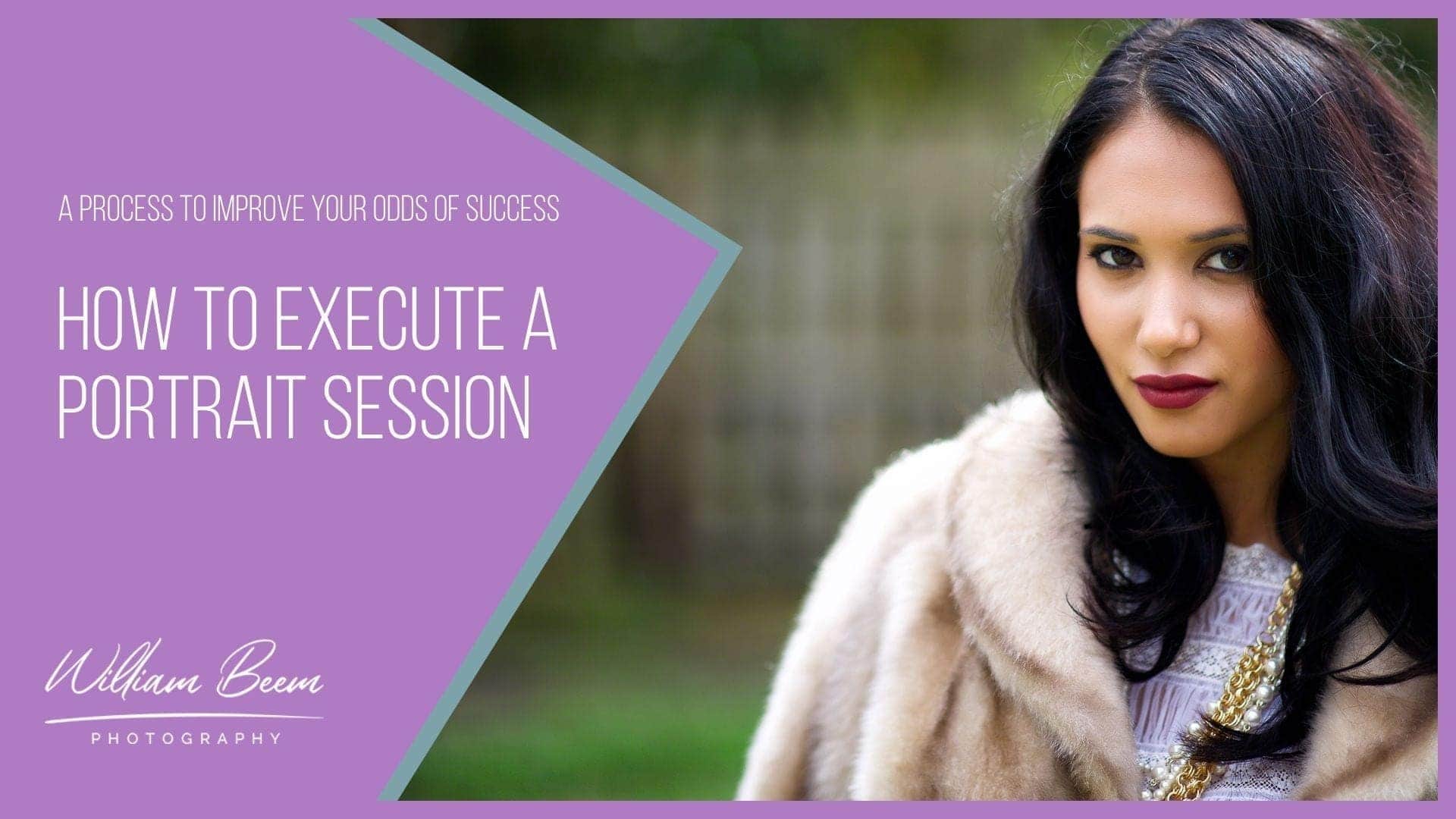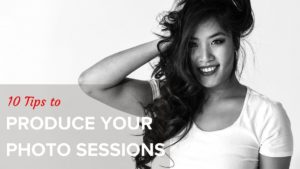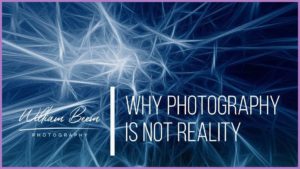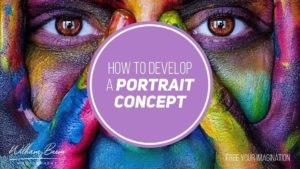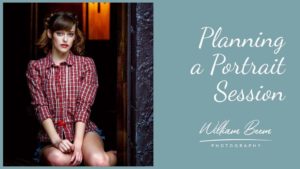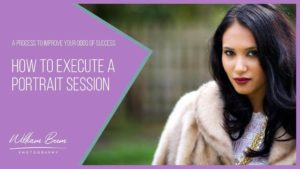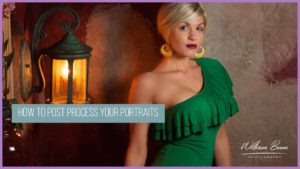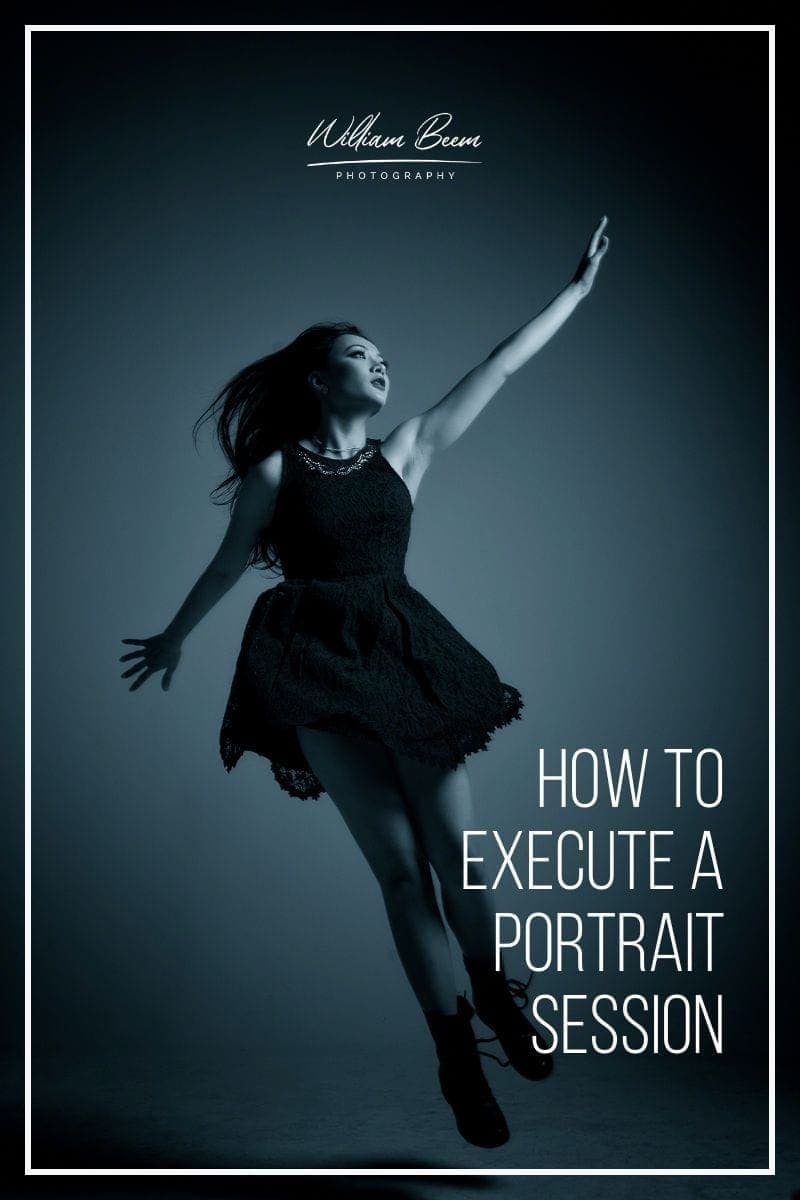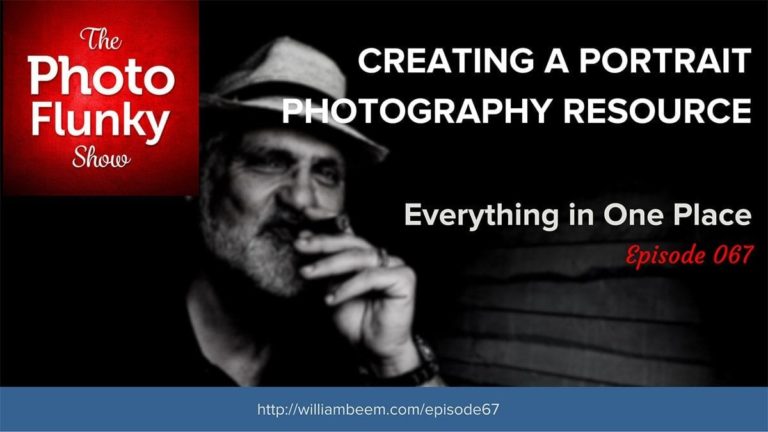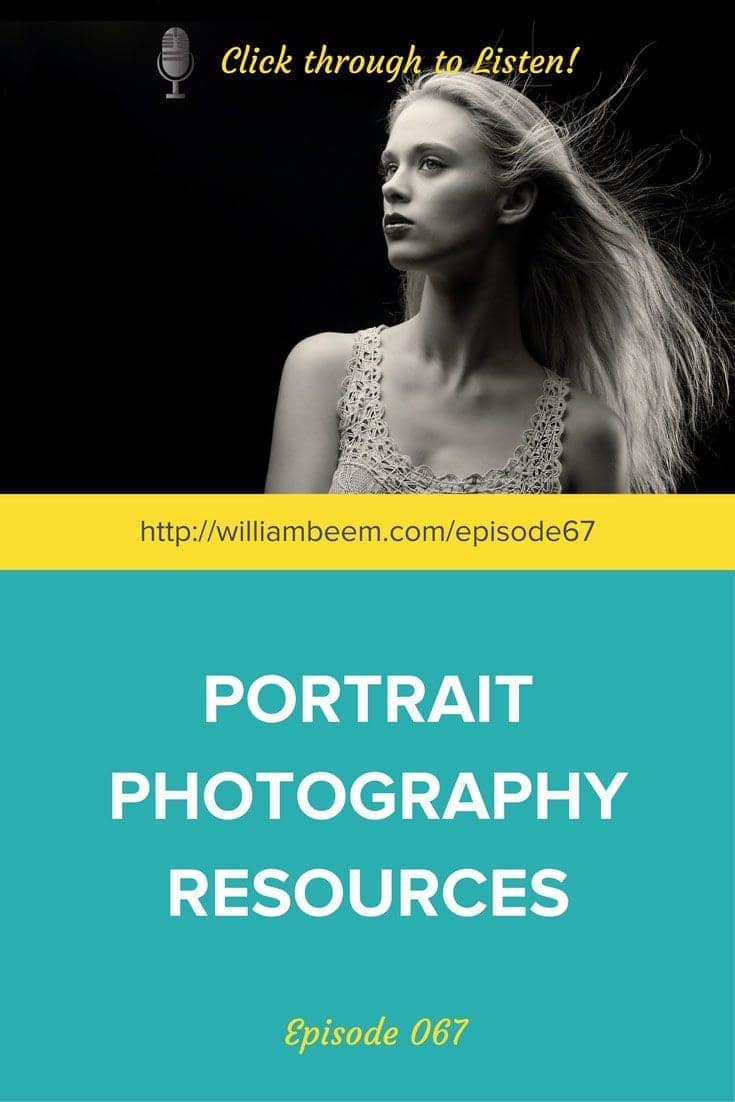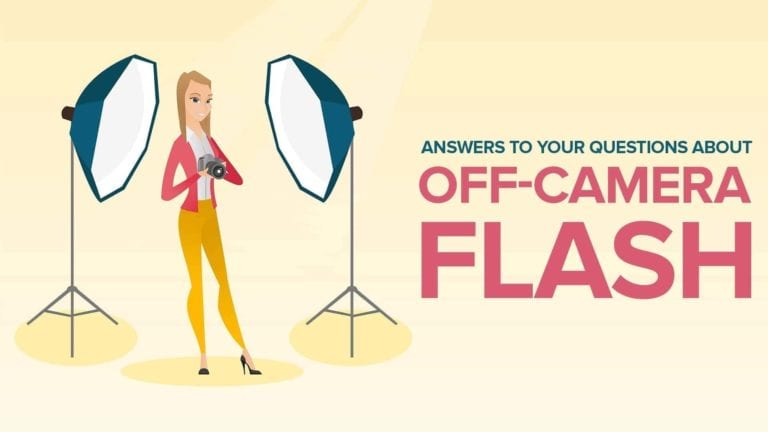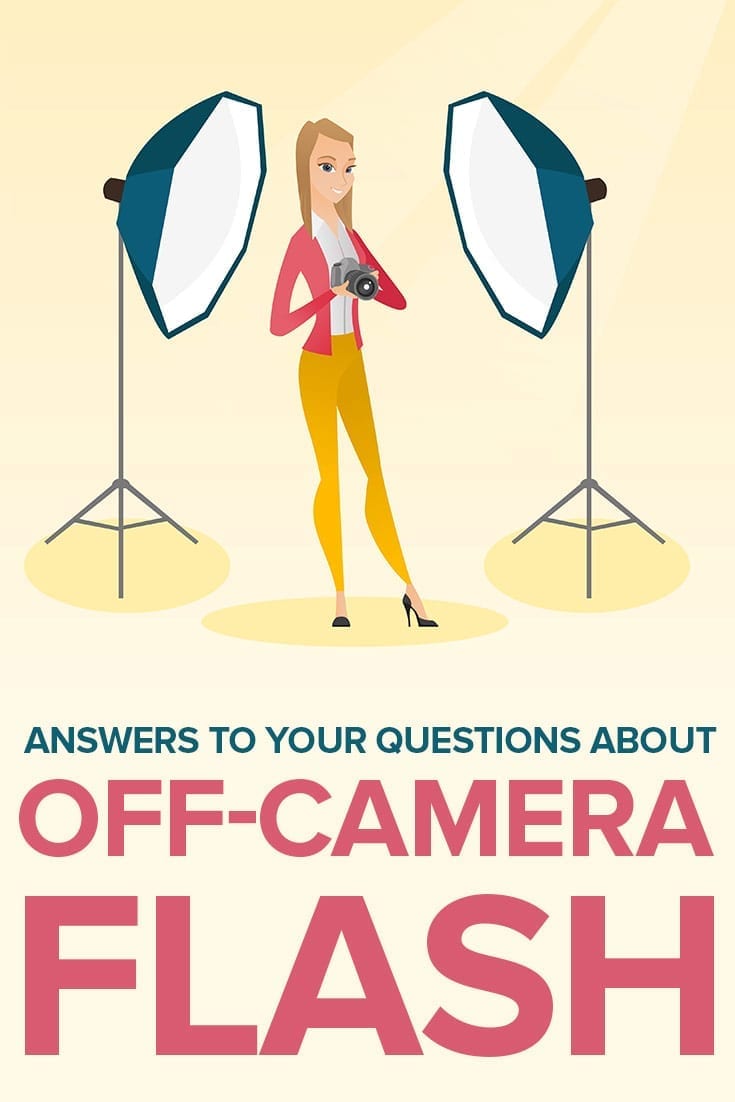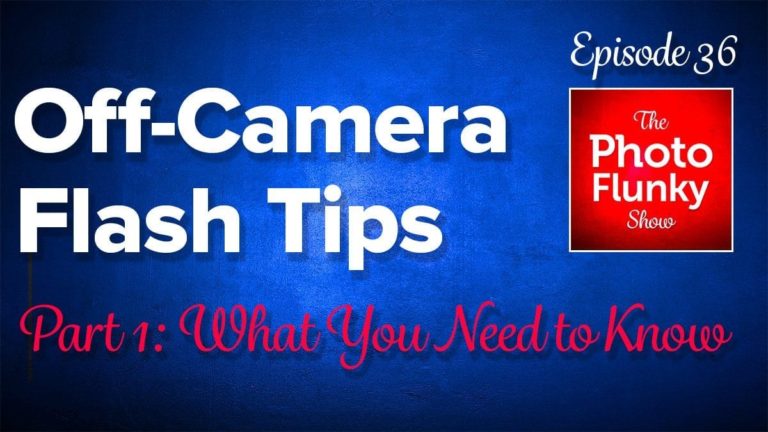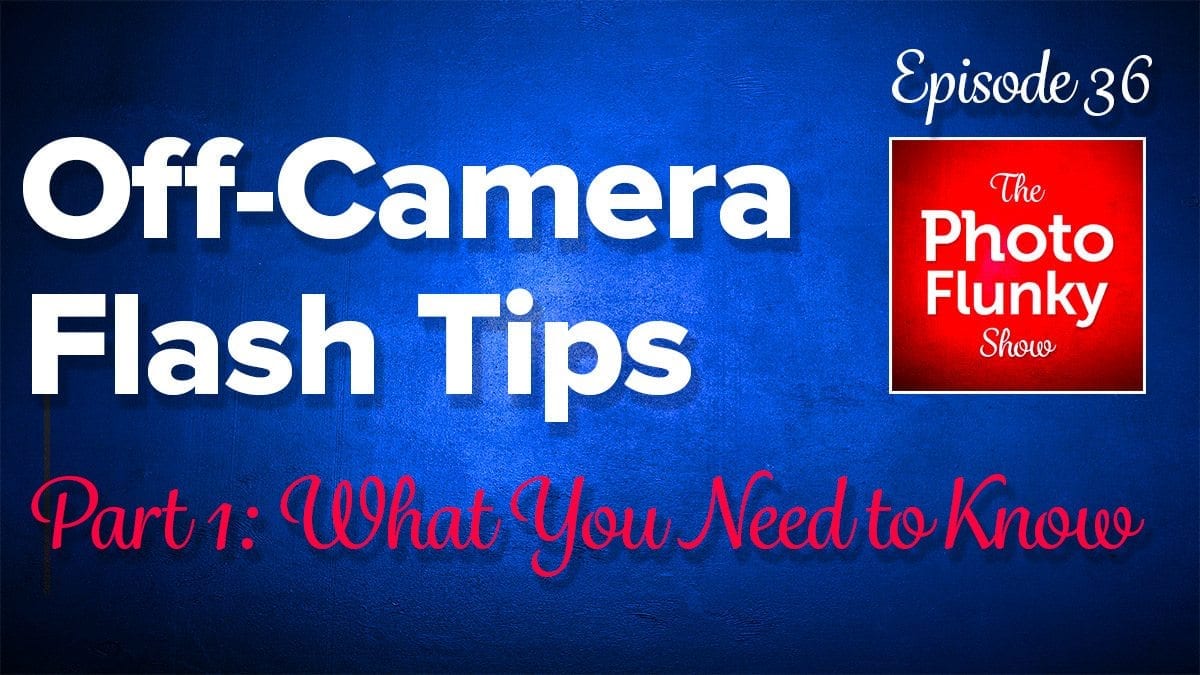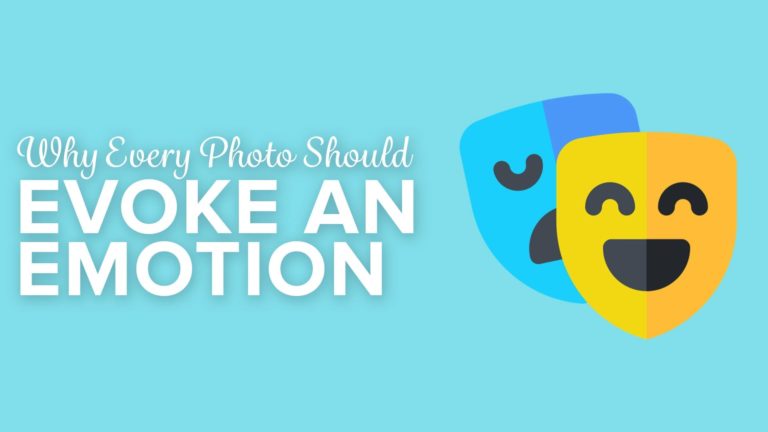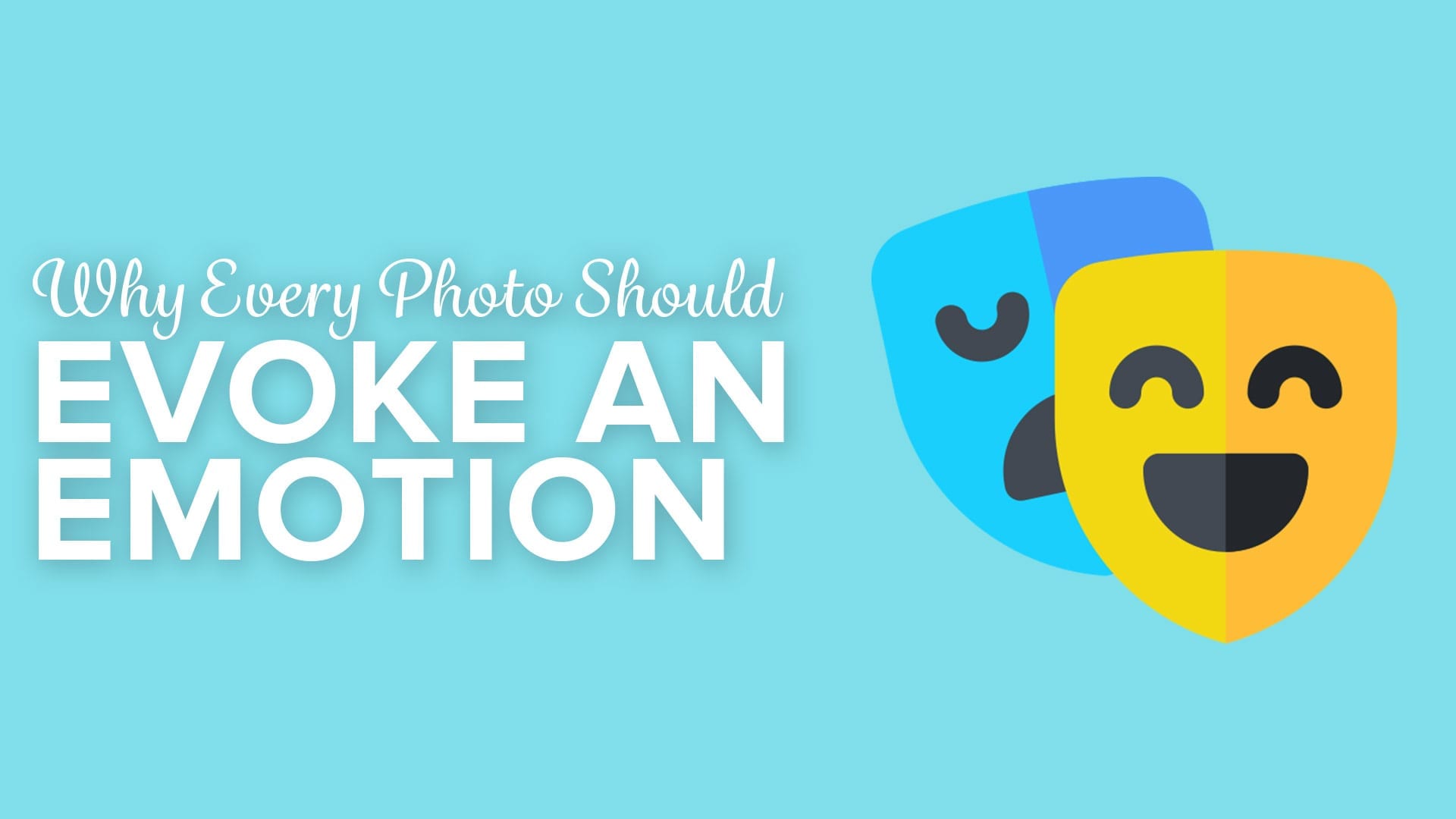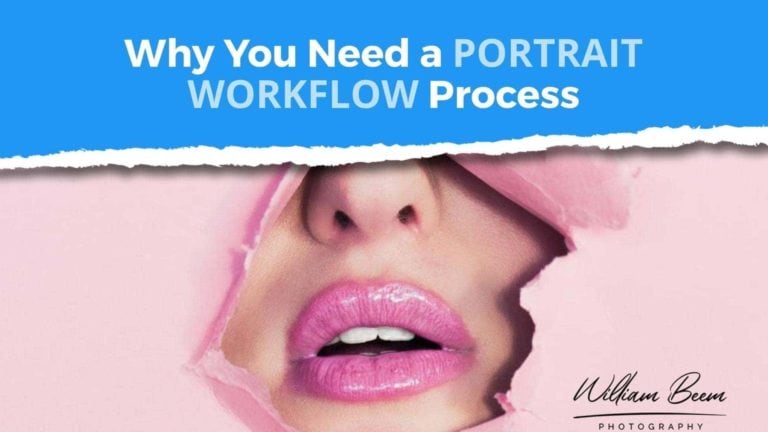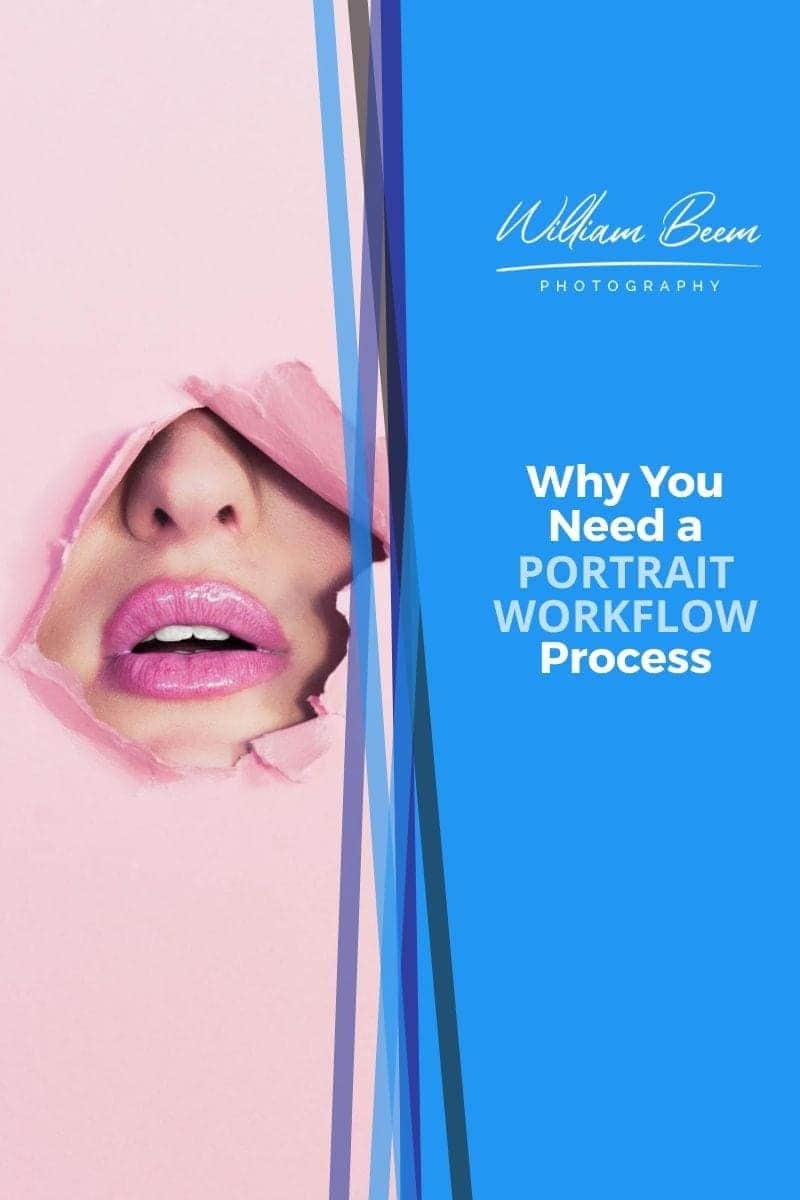Affiliate Disclosure: We earn a commission if you purchase through one of our links at no additional cost to you.
When I started portrait photography, I didn’t really know how to execute a portrait session. I thought it was fine if I showed up with a camera and someone else showed up willing to have me take their portrait.
In this episode, I’ll tell you the steps that helped me go from “just winging it” portrait shoots to the kind where I got great results. It doesn’t have to be complicated, either. It’s just a matter of knowing what things to think about while I’m on set – and we discuss those things in the episode.
I’ve been a photographer over 20 years and I started without a clue. Over that time, I’ve taken over 100,000 photos and narrowed down the concepts and techniques you can use to take great portraits that tell a story.
Let’s get started…
You Can Execute a Portrait Session, Too!
Lee and I discuss a lot of different roles and responsibilities in this episode. They’re important, but don’t think you have to make a big Hollywood production just to have a successful portrait session.
Instead, think about these roles and responsibilities, and who needs to make sure they’re covered. Trust me, it can work with just you and a subject. It’s easier if you have a larger team, but that also tends to be more complicated and potentially expensive.
When you execute a portrait session, you’re following a framework to help you, your subject and your team know what needs to be done at every stage of the production.
That means you get to think more like a producer or a director than a photographer, but you also get better results because you know what to think about. That’s much better than just winging it.
Timestamps
Today, we're going to talk about how to execute a portrait session. There are three things of really keep in mind about this is you want to be able to prepare your set and your talent for the portrait session. You want to set the tone for your portrait session and you want to get the most from your portrait session. In other words, how do you pull out everything you can from your environment,
your subject, and maybe the team that you have with you. And that's what we're going to talk about today on our I Like Your Picture. I'm William Beem. Welcome to, I like your picture, the show that helps you improve your photography with visual storytelling. What is visual storytelling is the method of approaching your photography with a knowledge of who you're trying to serve with your photos and what emotion you want to make them feel.
We encourage you to concentrate on your subject, light and background to create a photo your audience loves. I'm glad you found us. Hi, I'm William Beem and Lee Beem is once again dancing to the music as a, as we come into this, be happy. It's good to be happy. I wasn't happy to podcast and no, I don't want to have an unhappy wife when I'm podcasting.
That's just sort of do it all. Hey, today we're gonna be talking about how to execute a portrait session, and this is kind of part of the series that we've been discussing so far. Last week we talked about how to plan for your portrait sessions. So once you've got that plan in place, then you want to go ahead and we're gonna talk about the steps that you need to do in order to go through your portrait session.
Don't overthink it. These are steps that you want to remember for things that you cover so you don't forget them. But sometimes portrait sessions are simple. Sometimes they're more complex. We're giving you a lot of things to consider and a lot of roles that may be part of it. But keep in mind, you can do a portrait session as long as you've got someone behind the camera and someone in front of the camera.
A little story that I have is, the way I started off doing portrait sessions was just that very simple, almost kind of spontaneous, you know, spur of the moment kind of thing. And the problem that I ended up with is I didn't have any plan, I didn't have any concept. It was just me and whoever I was taking, a portrait of them were looking around,
trying to think of, okay, well let's make a good background or what kind of pose we put here. And sometimes we got some photos that we liked and most of the times we didn't. Yeah. That was the whole idea of this series that we're doing. It was like, you know how to take portraits that tell a story. And we think that those have much greater appeal to the people that you're gonna show them to,
whether it's a client that you have or if you're trying to share your, I guess, your artistic senses and vision with your peers. So no matter who your audience is, we're hoping that this will give you a framework that'll help you out. All right. So Lee, I like to pick on you, but I'm not going to make you start this time.
We've already talked about how to come up with your portrait concept. We've already talked about how to plan for. So now it's the day that you're going to do your shoot. And first thing I'm going to recommend is you do a quick review with your team. If you have other people there, at least with your subject and maybe a walkthrough and say,
is there anything here that's going to be a deal breaker? And by deal-breaker I mean something that says, you know what, we couldn't have anticipated this or something we need here and we can't get it and we just can't proceed without it. And that's the kind of thing that it, to me, I think it's kind of rare if you plan and prepare for things,
you kind of know ahead of time, but you know, maybe it's bad weather, maybe there's construction, maybe there's somebody there who says, you know what, you were supposed to have access but you really can't get in now because we changed our mind. So the first thing I would suggest that you do is you get onsite, you review your plan and your needs with your talent.
Make sure everyone knows their role, so your subject or subject. If you've got multiple people there, know what's expected of them. You have a photo assistance. Tell that person you know what you need them to do. Are they going to be gathering things or they may setting things up. They're gonna be carrying things or they're going to be adjusting lights while you're on the set.
Whatever it is that you need of that person, you don't make sure that they understand their role in that way. They can provide and deliver it to you. Same thing with your stylist, whether you've got a wardrobe, stylist, hair and makeup. You may want them just doing their job and then as you start shooting, looking at the subject to see if there's anything that's out of place that's going to ruin your picture because even though it may suck to be interrupted,
it sucks a lot less than getting home and finding out that your pictures really aren't that good because you missed the detail. And Lee, I know you've got a great eye for detail. So when you're looking at your photos, are you, do you find yourself, you set it up and then you're good or do you end up having to rearrange things to set it up?
Why is that? I mean cause you're, you're working solo so you're your own team basically. You set up everything. It's not perfect the first time or do you change your mind or what happens? Maybe a little bit of both. Um, pretty much I changed my mind because it's one thing having a vacation and I can have everything let's together in that vision.
When I look at it, I'm usually happy with the setup. When I want to do a test shot. Looking through a view finder gives you a very, very different picture, especially with your composition and maybe your liking and your shadows as well too. What it does when you are just standing and looking at it. Very true depending upon your perspective.
In other words, if you're doing top down or if you're at a different angle than what you would just normally stand there and see, and when I do my portraits, I don't really want to be at my usual height. I want to shoot from above or below somehow or to the left of the right. Basically. I don't want people to see things from the same perspective that they do if they're just walking around every day and to me that just adds a little bit of interest,
a little bit of dynamic to it, and the world looks different even if he's changed your lens, you know, if you're wide angle or telephoto, you may realize there's something there that you didn't notice just walking around before. Yeah. I think once you start going through a lens, you know, as soon as you adjust your, you zoom in,
you zoom out, it was changed. So changing your focal length, changing your aperture, um, all those things kind of changed the way that things appear and it may or may not work. So you got to play around with things for a little bit. So that's one of the reviews. Another thing that could be a deal breaker, I mean it could be your subject,
you know, if somebody shows up with a black guy and you're expecting a beauty shot at work. I had a friend of Lee's actually that we did portrait session on once in a gym and she came out with these big long socks, but they were like all of us under the butt cheek. I mean they were really big. And first off, it's just a personal thing.
Some people really like those. I doubt. I hate big long socks on anybody, men or women. Here's the problem, which just took those socks off. They'd left marks and lines all over her legs and those stayed for the rest of the photos. They stayed for the rest of the photo shoot. To me that was kind of like a deal breaker for any photos we took after that.
So that's something that's you kind of want to review with your talent is wear loose clothing so that you don't have anything that's leaving marks on your body. Well it's not really that. I think you have to design it like decide the order if you know how you're going to get dressed and that's where it's helpful. If you're not like for example, if you'd gone and spoken to him in a Bartlett,
she was going wear it, you know, what are your items to where you possibly wouldn't have picked that up because these aren't things that you typically wear or have experience wearing. So that's where it might be helpful to get somebody who knows that type of clothing. I mean I, I probably should have done that. The reason I didn't was it never in a million years occurred to me that she would put thigh high socks on because she's older than me.
Well, this is one of the things that I think worth if you have roles, so for example, we mentioned that there may be people who have to have more than one role, but let's say that you have hair and styling, makeup and wardrobe styling. If you had a wardrobe person on there, they would know to take a look at all the clothes and say,
okay, here's the order that we're going to shoot because of the way these things are going to leave marks on them. And the same thing may be true with hairstylist or makeup. It's like depending on what shots do you need, there may be an order that you need to shoot it in order to allow them to style somebody so that you don't have some kind of leftover perspective on the body or on the wardrobe based upon a previous shot.
We made the mistake and now actually I didn't say we, I made the mistake of not having her show me her wardrobe before we started. Yeah. If I had seen those socks, I think I would have just said, no, please don't. Or that would have been the very last thing. But now that we've had that experience, we saw the,
you know, you put on some clothing, it leaves marks behind on your body and if your next set of wardrobe exposes where those marks are, you're kind of screwed. There's those techniques you can use in Photoshop to try and fix that. But honestly it's very time consuming as much easier just to say, okay, let's put that on last against the skin because your,
your skin naturally kind of there. There's some kind of water collection in, you know, in the skin. That's normal thing. So there's a little bit of swelling. I mean, even like it's height bracelet, it could be jewelry, it could be somebody With a spare hair tie around their wrist, which is something that I'll always have on me.
But you know, I wouldn't think about that. But if I went to a photo shoot and my wrists were on display, I'd probably think, Ooh, I want to take this off. There would definitely be a Mark under there. Well, you could do something even simpler than that. A lot of male photographers like to go off and shooting with female models.
They might do a swimsuit shot, they might do something that's implied. If you're going to shoot something where skin is exposed, then you need the model to show up wearing something that's loose. If they come up when there's bras, straps, you know, or the back of the swimming suit is exposed or there's 10 lines, something's just not going to work.
Right, and these are things that you don't want to have that, Oh, I just thought of it right now. So you kind of want to have that conversation ahead of time, but it's also something that you want to look for on the day of the shoot because if it's there, that's okay. You just simply need to say, here's something that we can either work around it or this is the deal breaker.
Everybody go home. And that's kind of why I was bringing it up. It's not so much that you can't go back and fix what you didn't tell somebody, but these are things that you'd look for. These are things that you think about when you get on your scene. The next step after you've gotten everybody, you know the subjects are going into their makeup or preparing,
you know, whether they're doing of themselves or someone else's helping them. You want to make sure that your set is in order and I call this dress your set. Maybe you need to add something to it or maybe you just definitely need to arrange things on a location where you're at, but you, that's part of your walkthroughs. Like how does this look?
How is the light going to fall and what props or items do you need to stage on your set and lead? This kind of falls back with what you do. Everything you do is, it's not a studio, but basically you're building up from nothing and you're essentially dressing your set every time. Do you find that there's an order that you're looking at things when you're dressing your set?
Uh, yes there is. Cause they usually look at what I want to stand out. Most of the less that. So that's might be the subject or you know, with mostly food photography or I've got my little coffee photo thing that I was doing. Um, you know, in that case it would be the coffee, but if it's a food footer,
you know, if I'm doing tomatoes and chili peppers, um, then those are going to be the main color. So I kind of start with the color I went to stand out and then I decide am I going to go kind of subtle or complimentary colors or contrast in colors and I kind of build it off from the subject. And then afterwards when I bring in the details where any little accents or props or something to kind of,
you know, um, balance out the color, that's where those will get added in afterwards For a portrait shoot, one of the things I'm thinking of is whether this is going to be something in black and white or in color, and that's going to help me decide, am I looking for textures, tones, or colors in here? And usually to some extent you're looking for all of those things.
Black and white colors will still transfer to black and white in different shades. So you've gotta be thinking of your colors basically as what tone is this going to have if I do a black and white conversion? Likewise, if you're not going to do a black and white conversion, are those colors working together? Are they working with a wardrobe that you have?
And that's kind of something that I like to go over in the planning session. And you know what? You don't always get that choice. If the weather isn't what you want, maybe the sunlight isn't the way you need it to be. And you know that's some case. Can you overpower the sun and put gels on your lighting? Or do you need to say,
you know what, this day and the weather didn't turn out the way that we needed to. When you're dressing your set, you're also evaluating the lighting and how it's falling on your set. You kind of have an idea of where your subject's going to be. And here's the thing that some people haven't thought about is what shadows are your subject's going to cast on the background and how are you going to work with them?
Shadows are not a bad thing, but they're going to happen. And if you have something that's blocking the light over something that needs to be in the portrait while your talent is, you know, getting made up, this is a good time to work with an assistant and just do some tests and see what happens. How does the composition work? Where did the shadows fall and what kind of adjustments do you need to make in order to have a scene that looks the way you want?
Yeah, this is particularly a problem if he's using bright sunlight and you've got, cause what you want to do is like, typically you want to shoot not directly into the sun, but that means that your model or your subject is looking into the sun. I mean, I think everybody remembers those beach photos with parents as kids. Negative smile and you're busy kind of,
your eyes are closed, they go, your eyes are closed. While I'm blind from the sun, they go, okay three, two, one. But those are all things, I mean you don't want to do here three, two, one when you're doing a photo shoot if you can possibly avoid it. I think that's frustrating for the model. No.
Cause your subjects are typically going to either they're gonna stay very still or they're going to work in a flow and try and give you things and they're going to, and they're looking for your direction. When you're working with subjects and other people on your team, you're the one who sets the mood or what that set's going to be like. And that mood doesn't always have to be bright,
happy, sunshine kind of thing. You know, sometimes I like to have a lot of fun when I'm with on a set with somebody, but sometimes you need a different kind of expression or gesture or something from your model. And I hate to say it, but sometimes the way to get that is to piss them off. And I try not to do that.
But it's if you set a mood and you want that to show up, you want to get genuine emotions coming from your subject as best you can. And if your mood is something a little bit of a downer, then you know, maybe you're not going to be cracking jokes with them all the time because some people can act and some people can't. And you need to understand your talent and your subjects to say,
can they do this because they know how to show that kind of emotion or do you need to guide them into and lead them into that emotion based upon your own behavior, your own mood and how you make things feel on the set. Depends on the relationship you have with the subject. It really does because look, I don't want someone to have a bad experience with me as a photographer,
but I can get away with all kinds of things with me. Well, you're stuck with me. I don't have to worry about that anymore. But that's, that's something that you gotta think about is like if you have a mood that you need to get, I'm not saying that you go out there and deliberately upset your talent, but at the same time you don't necessarily want to make it light and airy and if you're shooting someone next to a coffin,
yeah, that would really be, unless that's what the family wants. Basically you're trying to make sure that your talent gets into character and that's easier done when you're in kind of the same mood as what the character needs to be. It doesn't mean that you're that way throughout the entire session's life. They come off and you know their snacks or something, they're sure have,
have a nice time to talk to them, make sure they understand where you're coming from, why you're doing what you're doing, but you need to set the mood and you need to make sure that you get the expressions from your talent that you need. And in most cases, I don't think it's going to be a downer or a big problem. I don't do a lot of things,
you know, with coffins. I don't have any coffins in my portfolio, but there are times when I may want to show loneliness and I've got a couple of portraits where someone is waiting for someone else to come through or there's an expression that comes with, you know, somebody who's looking out the window waiting for somebody and you don't want someone always smiling through every photo that you do.
Maybe sometimes that's not the mood. So you got to decide what's the mood and how are you going to get those emotions coming out of your talent. All right, so you've done some test shots, you've looked for shadows, you've got your talent on the set, you've got the mood going on that you want to have. Now. Honestly, it's time to work the scene and for me that means looking for different perspectives,
but also asking for input from the team. What kind of ideas do you see at that time that maybe weren't in your portrait concept, but you have opportunities because you see things differently, like when you're actually present, what to do when it's just the concept. I look at it this way though. The plan that you come up with. I mean you've got your concept,
your concept is going to change a little bit. When you get through the plan, the plan is going to change a little bit. When you get on site and you're actually doing things and it's just like so many other things, like you can't necessarily have a strict architectural diagram of how every little piece is going to be when you're dealing with people because people bring their own perceptions and emotions and whatever else they have that makes up who they are with them to the shoot.
This is a collaboration, so in my mind you need to be open to suggestions and also I found it's good to get input and ideas from your team basically to value them, to show them that, Hey, this is a collaborative effort to make something creative what you have and also part of your agreement with those people rather than paying them cash. Maybe that they want these photographs for their own portfolios.
Like here I did the wardrobe on this photo here I did the hairstyling on this photo, whatever that may be. If they're going to be getting copies of this portrait, then you need to include some of the things that they may have in mind. And maybe you do several versions of the portrait so everybody gets a little something of what they want. That's actually a nice idea that you're willing to give a little as well.
Thank you. I'm glad you liked that. I thought that I thought about it all by myself. Well, I'm becoming redundant here. No, not at all. But I do think the idea, if you're going to collaborate with people, you want to get everything they have because I will tell you, I can't think of everything. I can't tell you how many times Lee comes up and gives me ideas that I never considered just with everyday life around the house.
Useful, excuse me. Useful. Even if the suggestion is, you know, is this yours? Do you wanna pick that up? All right, so you've gone through, you've gotten your input. You don't necessarily want to be chimping with every shot, but there is a time that you want to get together and review the images with everyone on your team.
Yeah, that's a good idea. While they're still there, while you're still there and if you're dependent upon, you know, the light fading, you know, from sunset or sunrise, you know, changing, you want to do this quickly. But I like to bring a laptop that's tethered to the camera and I can see things as they come through.
But the nice part about that is instead of having to really look at a tiny little screen on the back of your camera where you may miss some details, I like to have a laptop there that's tethered so everybody can kind of gather around and look through and say, Oh, I like this. And maybe they'll come up and say, wait, what is that coffee cup doing there?
Yeah, I mean there's tiny little things that you get busy and you're looking at expression and gesture and all these other things and you forget about some piece of clutter that you don't really want to have to deal with. Or maybe there's a shadow on someone's face. You know, it's like someone raises their arm up and you didn't realize that that arm blocked the light.
And cast a shadow on the face of the person behind them. And then you've also got the opportunity while everyone, everything is still there. If you really need to retake something, I mean, some of this stuff goes wrong. I learned the hard way. I, I know initially with a few coffee photos, I kind of got the shots, I'm happy,
and then looked and found there was a problem. And by that stage I'd already done two different sets. So I had to go back to the photo that wasn't great and figure out how I had everything and try and rebuild it. So it is kind of easier, but at least everything was still kind of Aston available. It's easier to fix things while you're there on the spot.
There have been times that I've come back from a location, shoot a shoot at a studio someplace or even traveling, you know, they're some of my photos I looked at from whether I was in st Lucia or Cuba, and I'm thinking, Oh, I would love to go back and change this little aspect of it. Or I'd like to, now that I've seen this,
I'd like to go back and do something else with it. I didn't think of this expression or gesture or maybe putting a couple of people in the same place. All those little ideas you get after you've looked at your photo. If you don't look at them on the spot with your team or the very least you know the subject. If it's just the two of you,
you don't know until you get home and then what are the odds that you're going to go back out and recreate everything you need just to fix that problem and just not be fixed in post-processing, certainly not or not easily. And I thought, you know, make it easy on yourself. Make sure you review things. And this comes back from your preparation.
You had your concept, so you know kind of a shot list of what you wanted to get, get what you planned on getting and then get any extra little things you think of and review all of those. Is there anything that you need to go back and redo or do you have a new idea? Maybe that you didn't have before and it's amazing what comes out of that little review of your images.
I'm super lazy with place processing, which is probably anything that keeps me in check cause I want to use post-processing to enhance what I've done. I do not want to have to rely on it to fix things. Well that's really what it's there for is to enhance stuff is not necessarily there to try and save a broken or bad photograph. I think that's where a lot of people go wrong with post-processing is they're trying to save a photo and I don't know if you don't have a good photo to begin with,
you're not really going to save it. It's, I mean, can you crop something out on the edges? Maybe that's possible, but if you've got something that's just really in there and is casting a shadow and it's in the wrong place, it's just don't, don't even bother. That's my perspective anyways. All right, so you've got your review of images,
you've done any reshoots or any new ideas that you and your team came up with and congratulations. You've done everything except for clean up and go home. So the next part is obviously tear down your set, put your gear away, pack up the wardrobe, and just make sure you leave the place better than you found it. One of the things that's become a trend lately with a lot of photographers,
particularly at this time of year, it's, it's in may and people are graduating, people are getting ready for engagement shoots and they've got this thing where they pop confetti into the air and then they leave it there on the ground. Yeah, and I've seen this at, you know, a few parks around here. I've seen photos that other people have posted.
It's like they go off for these celebration photos and it's exciting, makes a beautiful photo, you know, happy people and they leave a bunch of crap all over the place. If you go someplace, clean it up. If you go to a studio, they're going to guarantee that you clean it up or you're gonna end up paying or you're gonna pay for someone else to do it.
There may be a deposit that you don't get back or who knows what it is. But wherever you go, when you're tearing things down, put things in their right place. Don't leave anything behind that wasn't there before you got there. And that's just the right way to handle things on a set, whether it's indoors or outdoors. You people shouldn't know that you were there and had a photo session or a portrait session when you leave.
How's that going for a picnic in the park? Trashing the cat. People still do that. This is the boy scout in me. You know, we were always told to leave our campsite, you know better than we found it. And I thought, well, I don't know about that because, But do you know what people, if you're, if you're renting a studio or a location or if you've had to get permission,
people will notice how you left it and even, you know, it's good enough to kind of leave things as you found them. If you leave things, you do a really good job tidying up. People do start to notice narrowly too happy to have you back so they know that they don't have to worry about it afterwards. This is the hassle free rental.
That's a very good point and particularly if the location, maybe if you didn't even pay for it, you just negotiated and they said, Hey, come on in. And then if you leave them a mess or if you damage something without addressing it and making you know some kind of remuneration for it And make sure you know of another place to go next time.
Yeah, they're, they're not going to want you back in a matter of fact, if anyone asks about you, they're going to say, Oh that, that jerky left a mess for me. Tear down your set, pack your stuff away, leave things the way you found them and if there's something you can do to make it a little bit better,
that will make people feel better about allowing you to come back. Finally, I would say give some feedback to your team. They all kind of want to know did we accomplish what we did? Are we going to get our photos anytime soon and I do that with people I shoot with. I don't do that with my family. They're still waiting three years for me to give them photos.
Correct, But we don't pay you, But they weren't a team. We'll discuss this later. Yeah, this is, this is one of the things where at least with family I need to do a better job, but people want to have feedback. They want to have, I guess a little bit of sense of closure of what's done for the day,
how they did, and you obviously if someone's didn't quite live up to your expectations, you don't want to chastise them in front of the rest of the group, but let them know that you're going to follow up with them later. You know? So that way you can say, here's how things work and make sure everybody knows what to expect from you next because you're the guy going off with the photographs and if you're taking those photographs and not delivering them,
people are going to be curious, when am I going to get my photos? Am I ever going to get my photographs? Kind of set some expectations with your team as you go and finally go home. Get out of here. Well, You don't want to stay there all day. You've got a whole bunch of other photographs and that's what we're going to be talking about next week is a little bit about post-processing,
your photos and then we'll follow up with delivering your photos on the podcast after that. So hope this helped and we kind of wanted to just recap what we were talking about is, you know, prepare yourself, prepare your talent, set the tone for your portrait session and to get the most out of it. That's where you're really going to be looking through everything,
working with your team and collaborating with them. Remember, the whole point of having a team is collaboration. Thank you so much for joining us on. I like your picture. This is episode two 17 so you can find show notes [email protected] slash episode two one seven as I said, this is part of a series that we're doing, so you can go back past couple of episodes to episode two one five and two one six now two one seven.
Hey, well, I think we're going ahead to two one eight and two one nine I hope you're enjoying this. We would love to have your feedback, so if you go to
We'll see you again next week.
Related Links

